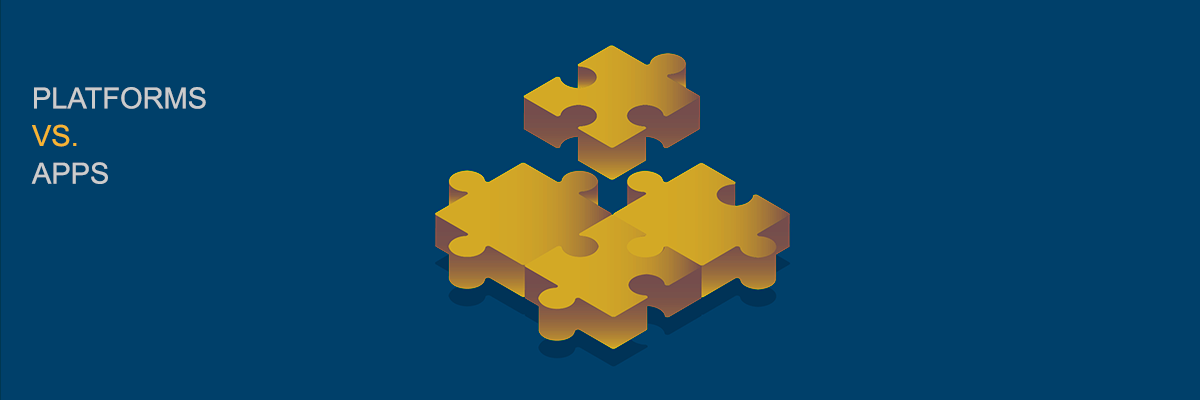As small and medium-sized businesses seek to mobilize their workforce with apps that integrate with the ERP, they are encountering a serious problem.
For one thing, it becomes evident very early on that there are processes or activities that need to be recorded and stored in the system, but that aren’t integrated as part of the ERP. This causes a ripple-effect of delays where information is too slow to get to the parties that require it, and what information does get through is often fragmented or incomplete. Although employees have more freedom than ever to download and collaborate using apps, and it may feel like an improvement, the fact is that the information is out of sync with the ERP.
Secondly, SMB’s vary widely in their needs. The apps they adopt often require customization (coding) which is not a core competency of the business. The SMB is then reliant upon the App developer for coding the customization which is expensive and time consuming. The apps also require their own integration with the ERP. This may be manageable for one or two apps, but as they proliferate around the business all of this becomes a lot to manage.
Software Apps versus Platforms – The Problem with Programming
In order to understand what differentiates a platform from a software app, it can be helpful to look outside of the world of computing. Lego is a perfect example. These timeless building toys have grown beyond simple blocks that children can use to create whatever their imagination can dream up. And all of this evolution in what is possible with Legos is grounded in basic reusable components and repeatable patterns within a common framework. A platform that enables each child to build their own solution.
With this as our foundation, let’s look at how this idea can also apply to SMBs. There are numerous potential uses for such a platform, replacing the aforementioned app proliferation conundrum, where custom coding and integrations hog-tie the SMB. A system that allows the business stakeholder to be much closer to solution creation reducing the project overhead associated with software development. And like a child creating a Lego structure, configure and deploy multiple solutions from reusable components and repeated patterns.
Conversely, lacking the platform, the end user is constrained by the confines of what is and is not allowed within the parameters of the software. They cannot “create” nor integrate things efficiently. Even in the best possible cases where the developers are cognizant of the end-users’ needs, they cannot account for every possible iteration of every possible SMB and industry.
The Enigma of the SMB and Their Ever-Changing Needs
The SMB is a common target market for rigid, single-purpose apps. But the SMB is not a concrete, easily-definable entity. Their needs change and they must adapt to the changes, trends and whims of the market or be left behind.
In the case of the SMB, adaptability is crucial. Even if the SMB leverages software that’s built on a platform, most SMBs don’t have access to a knowledgeable development team, so they rely on external companies to handle customization of their ERP system. Over time, they begin to seek out new suppliers, new delivery methods, new tracking systems and a whole host of other potential changes and updates.
And this is where rigid, single-purpose apps come up short for SMBs. They can’t flex affordably to meet their unique and evolving needs. It can’t keep up, even under the very best of circumstances. SMBs quickly realize that such a system can quickly become bloated both in terms of code and expense. Unlike Legos, the SMB can’t simply replace a green brick with a yellow window because they’re easily interchangeable on the platform!
The Platform Puzzle: Putting the Pieces Together
With these faults in mind, how can a platform-based solution not only address these challenges, but overcome them?
Much in the same way that children can easily pick up and understand how Legos work without much instruction or guidance, a platform-based system needs to be able to accommodate the SMBs’ needs without a lot of technical intervention.
When the end user themselves can update and build upon the platform without needing a dedicated roster of developers on hand and without needing to try and surmount the high learning curve that advanced coding requires, an amazing thing happens:
The solution creation becomes more like a puzzle, where interchangeable pieces fit together and can be mixed and matched in an adaptable, flexible framework that’s built from the ground up to allow for customization and improved efficiency.
And much like the young child unleashing their imagination through a series of colored blocks and figures, SMBs can easily integrate people, processes and systems on a single streamlined, easy-to-understand platform that not only accommodates their current needs, but is built to anticipate and adapt to their future needs as well.
The end result becomes much more cost efficient and affordable, while allowing for maximum compliance with requirements, as well as the fluidity to adapt with the ever-changing pace of demand and supply. No special skills or coding needed. No intensive learning curve to wade through. Just simple yet powerful and actionable integration for the features that today’s SMBs need to thrive.
About Versago Platform
Versago is a web and mobile platform integrated with SAP Business One enabling the broader population of people and processes across a business’ ecosystem to leverage the power of SAP for every function supporting growth and operating efficiency.
Versago is easily configured to support multiple use-cases to grow your business. With its extensive library of pre-built functionality and workflows already integrated with SAP Business One, your business can be up and running in less than a day with no software development required.
Benefits of Versago & SAP Business One:
– People and Processes Always In-Sync with SAP Business One
– Simple User Experience, Low/ No Training
– One Configurable Platform vs. Multiple Apps
– Streamlined Processes with no SAP Manual Data-Entry Bottlenecks
– Paperless Processes
– Faster Customer <> Supplier Interactions
– Branded to Reflect Your Business
– Increased Customer Satisfaction with Digital Solutions
To learn more about how we enable companies to implement scalable ERP solutions, schedule a customized Business One demo with a Third Wave expert today.

Platforms vs. Apps – A Critical Choice for SMBs Running on SAP Business One
Learn More
Distribution and wholesale companies are critically dependent on connected business processes. Managing flexible relationships with vendors, customers, and sales teams is crucial to the success of these businesses.
An ERP system helps distributors and wholesalers take control of and streamline business processes by integrating inventory, logistics, sales, and back-office functions. Their business’ gain a centralized source of information that can be used to improve decision-making throughout an organization.
Most companies and their employees participate in an ERP implementation project once every 10 plus years. ERP system implementation is not a skill set available within most companies who tend to hire for functional areas such as operational, financial, sales, purchasing, eCommerce and warehouse operations.
Distributors and wholesalers who work with an ERP partner with industry-specific functional background, ERP systems and technical expertise, and a proven implementation methodology augment their team with a strategic resources. A partner with the right combination of experience, knowledge and project management ensures a successful ERP implementation.
SAP Business One for Distributors and Wholesalers
SAP Business One provides distribution and wholesale businesses with tools that can improve business agility and operational efficiency, while providing a significant competitive advantage. Streamline and optimize business processes while leveraging business intelligence for smarter decision-making with SAP Business One’s ERP solution for growing companies.
Third Wave Business Systems are proven experts in SAP Business One implementation for distributors and wholesalers, providing clients with the industry expertise, implementation methodology, and ERP systems experience needed for a successful implementation and future projects.
Third Wave’s ERP Implementation Process In Six Phases:
1. Project Launch
Initial planning, agreement of project scope, and confirmation of the overall project structure. A high-level project plan will be completed, and a test system installed.
2. Business Process Mapping
Outline existing business processes, introduce SAP Business One best practices, and modify the initial project plan if required. A detailed project plan is provided along with project team training.
3. Build and Configure
Build and configure all business processes and technical requirements, and prepare the system to perform a proof of concept test.
4. Testing
A series of test scripts will simulate the business while validating the application configuration in a non-production environment.
5. Business Readiness
Assess system, staff, and organization readiness, staff readiness, with a final decision to move to production. End-user training is provided, along with a final cutover plan.
6. Go Live
The client organization starts managing daily activities while the Third Wave team monitors the activities and provides support. The project is signed-off, and follow-up items are scheduled.
Third Wave’s execution of implementation methodology, project scope definition, and project management discipline can help distributors and wholesalers to eliminate common problems like poorly implemented functionality, missed project dates, project budget overruns, and any other unwanted surprises. A plan and methodology without proper execution is nothing but a wish.
About Third Wave
Third Wave Business Systems is the most experienced SAP Business One Gold Partner in North America. Small and growing businesses trust us to implement ERP solutions deployed on-premise or in the cloud with industry, functional, and technical expertise every step of the way. Our leadership team ensures that each customer benefits from both our implementation discipline and creative problem solving to support their current and future business process and integration needs.
To learn more about how we enable companies to implement scalable ERP solutions, schedule a customized SAP Business One demo with a Third Wave expert today.

Steps for a Successful ERP Implementation Plan for Distributors and Wholesalers
Learn More
When purchasing an enterprise resource planning (ERP) solution, decision-makers must understand how each ERP pricing option can affect their business for both the short and long-term. Understanding the differences in each pricing structure can prevent businesses from overspending as well as increase the ERP system’s return on investment (ROI).
There are two ways to purchase an ERP solution. The first ERP pricing option is a one-time license fee with an annual maintenance fee. This option provides a perpetual use license for the software that allows you to use it as long as you like.
The second ERP pricing option is a subscription or Software-as-a-Service (SaaS) fee that allows you to use the ERP solution as long as you pay the subscription fee.
SAP Business One ERP Pricing Options
Unlike many ERP solutions, SAP Business One can be purchased using either pricing model, For example, a company may choose to implement SAP Business One with the SaaS option deployed in a multi-tenant cloud, or may prefer a private cloud or on-premise server deployment with a one-time licensing fee option.
Our ERP Pricing Option Recommendation
At Third Wave, we believe that the license/maintenance fee option is the best ERP pricing option for all organizations for several reasons:
- You gain the flexibility to deploy the ERP software either on-premise, in the private cloud, or a multi-tenant cloud, with the freedom to migrate SAP Business One between deployment options.
- Your business owns the software versus subscribing/renting. Even if the maintenance fees are not paid, the company will still be able to use the ERP system and access their data.
- After about three years, the license/maintenance fee option becomes increasingly less expensive than the SaaS fees. This is due to the fact that the annualized cost of the one-time license fees and annual maintenance fees drops significantly over time, while the subscription fees for the SaaS model stay consistent or increase year-to-year.
- The license/maintenance fee model also makes it easier to work with the ERP partner best aligned to your company’s needs.
About Third Wave Business Systems
Third Wave Business Systems is an SAP Gold Partner, the world leader in ERP software. As North America’s longest-standing SAP Business One partner, businesses trust our experts to implement ERP solutions for both on-premise and cloud ERP deployment models providing in-depth industry expertise every step of the way. Our experts work with you to understand your business needs and goals and to choose the best ERP pricing option for your business.
To learn more about ERP pricing options with SAP Business One, schedule a customized SAP Business One demo with a Third Wave expert today.

Which ERP Pricing Option is Right For Your Business?
Learn More
An ERP implementation can be one of the most complex projects a company may undertake, with consequences that can impact the entire organization. Developing a CPG ERP implementation plan is a vital step in the process, helping your company to minimize disruption to employees and get the system up and running as quickly as possible.
For companies in the Consumer Packaged Goods (CPG) industry, the business environment is continually evolving. An ERP solution must be adaptive enough to meet changes dictated by a global supply chain, direct to consumer sales and direct to consumer drop shipments and increasing trading partner demands to remain competitive.
The most valuable benefit is how an organization-wide ERP deployment links disparate business functions together throughout a company. For example, SAP Business One can streamline operations through process integrations and automation to manage today’s purchase-to-pay and order-to-cash processes.
SAP Business One offers the flexibility to accommodate the unique needs of an organization, with the ability to adapt to changes within the company, the business, or the ecosystem.
Tailoring CPG ERP Implementation For CPG Businesses
Enterprise CPG companies have unique business challenges that an ERP solution like SAP Business One is well-suited to solve. Since eCommerce and EDI play a significant role with CPGs, an ERP solution can help through integration and process automation that enforces the rules of multiple order-to-cash and purchase-to-pay processes, resulting in greater transaction throughput with fewer people, greater accuracy, and reduced chargebacks.
A goal of a CPG’s ERP implementation is integration with the eCommerce platform. This integration automatically pulls orders into the ERP system and pushes updates back to the eCommerce platform. EDI integration is the other must-have for consumer product companies.
Enterprise CPG companies must manage multiple sales channels: big-box retailers, specialty retailers, online marketplaces, B2B and B2C, eCommerce, and more. Many of these sales channels require EDI integration to facilitate the communication of Purchase Orders, Advanced Shipping Notifications, and Invoices. Managing different shipment configurations and options is also crucial.
While an ERP system can provide a company with many benefits, it’s critical that a detailed, organized plan is created to ensure a successful implementation and ongoing benefits. To ensure the success of your CPG ERP implementation and take full advantage of the benefits it provides, select a partner like Third Wave Business Systems with the knowledge, industry experience, and skill to help you create and execute a comprehensive implementation plan.
Third Wave’s ERP Implementation Process In Six Phases:
- Project Launch: Initial planning, agreement of project scope, and confirmation of the overall project structure. A high-level project plan will be completed, and a test system installed.
- Business Process Mapping: Outline existing business processes, introduce SAP Business One best practices, and modify the initial project plan if required. A detailed project plan is provided along with project team training.
- Build and Configure: Build and configure all business processes and technical requirements, and prepare the system to perform a proof of concept test.
- Testing: A series of test scripts will simulate the business while validating the application configuration in a non-production environment.
- Business Readiness: Assess system, staff, and organization readiness, staff readiness, with a final decision to move to production. End-user training is provided, along with a final cutover plan.
- Go Live: The client organization starts managing daily activities while the Third Wave team monitors the activities and provides support. The project is signed-off, and follow-up items are scheduled.
Third Wave’s many years of experience shows that a properly executed Testing Phase is key to a smooth transition to the Go-Live phase. Third Wave’s methodology, scope development, and project structure help to eliminate common problems like misaligned business processes, time overruns, unclear roles and responsibilities, and any other unwanted surprises.
Third Wave is a Gold Partner of SAP, the world leader in ERP software. As North America’s longest-standing SAP Business One partner, small to enterprise level businesses trust us to implement ERP solutions deployed on-premise and in the cloud with hands-on expertise every step of the way.
To learn more about how we enable companies to implement scalable ERP solutions, schedule a customized demo with a Third Wave expert today.

Developing an ERP Implementation Plan for Enterprise CPG Businesses
Learn More